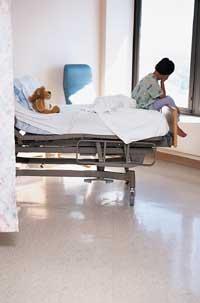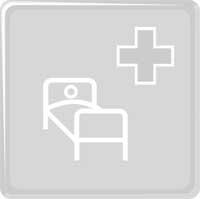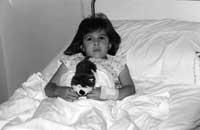Meningitis with a little light
2003/02/01 Agirre, Jabier - Medikua eta OEEko kidea Iturria: Elhuyar aldizkaria
Why do meningitis occur?
Inflammation of the meninges is almost always caused by an infection and the germs responsible for meningitis are in most cases viruses or bacteria.

Viral, viral meningitis are the most common in childhood. In 90% of the cases are caused by viruses in the enterobiruses group and evolution and prognosis, except for exceptions, is usually very good. This type of meningitis occurs in the form of an epidemic in the temperate months (especially in late autumn, and occasionally also in mild autumn).
Bacterial meningitis is less common. The most common bacteria are pneumococcus, meningococcus (type B and C) and, to a lesser extent, Haenophilus influenzae type B. This type of meningitis is a very serious disease. Therefore, doctors try to fight the disease by two ways: on the one hand, introducing the appropriate vaccines in the vaccinal calendar (such as anti-Haenophilus or anti-meningococcus) and, on the other, applying an aggressive treatment once diagnosed the disease. This type of meningitis is more common in winter.
How to know what meningitis is?
The symptoms of meningitis are different depending on whether it is viral or bacterial, in addition to the age of the child. It must be said, however, that in the beginning (in the first hours) meningitis and viral infection cannot be differentiated without importance.
For viral meningitis, a toothed child usually has severe headache, vomiting, and fever (not too high). If the child is younger, the headache is replaced by irritability (continuous crying). And children can be like this for several days (the difficulty of making a differentiating diagnosis is easily understood).
In the case of bacterial meningitis, if the child is toothed, there are headaches, vomiting and fever, usually high. In the early hours you can also think that it is a flu, since they are very difficult to distinguish. But within a few hours the situation of the child is greatly aggravated (weakness, sleep). Spots or spots often appear on the skin.
In younger children, bacterial meningitis begins with symptoms similar to milder ones: fever, vomiting, and irritability. However, a few hours later there is a bending, bad appearance, stiffness of the nape and even skin spots, in some cases.

When a child has meningitis, in addition to increasing or inflaming the meninges, the fluid that moistens and soaks cefaraquídeo (CSF) is altered. Therefore, to make the diagnosis it is enough to check the CSF of the area of the meninges by a puncture in the waist: a puncture is performed in the child's spine, between the two lumbar vertebrae, and in the sample the CSF is analyzed and meningitis can be confirmed or ruled out. This fluid also helps to clarify whether meningitis is caused by a virus (the CSF that comes out of the puncture is clear) or if it is produced by a bacteria (in this case the CSF is usually more "dirty"). The decision to perform this lumbar puncture will logically be made by the doctor after a thorough and rigorous study of the child.
Blood tests are not helpful in diagnosing meningitis, but they do serve to differentiate whether meningitis is viral or bacterial.
What to do with suspected meningitis in the child?
If the child is considered to have symptoms of meningitis, go immediately to a health center.
But not all kids with headache, vomiting, and fever have to go to the hospital, much less. In most cases, these are mild diseases (viruses, flu) or other less serious infections (pneumonia, urinary infections...) that will be immediately diagnosed by the child's pediatrician.
However, if the situation of the child worsens (tendency to sleep, difficult to answer, difficult to speak, difficult to move the neck — the neck —, difficult and painful, etc. ), so yes, it is recommended to go immediately to the emergency room.
And what not to do?
Do not give antibiotics to the child without warning to the pediatrician. If the child has headache, vomiting, and fever it is advisable to consult the doctor but not to self-administer an antibiotic. If the child has lung disease, the antibiotic will never heal orally and will also put difficulties and obstacles to the correct diagnosis.
How to prevent meningitis?

Vaccinations Several vaccines have managed to eradicate some diseases. This is the case of the Vu vaccine against Haemophilus influenzae type b. This vaccine was introduced a few years ago in our immunization schedule and since then has drastically decreased the number of meningitis (until practically disappear) caused by this germ. And we hope the same happens with the vaccination against meningococcus C that has been included this year in the calendar. Unfortunately, we still do not have vaccines against germs that cause two frequent bacterial meningitis (that is, a pneumococcal vaccine and a meningococcal type B vaccine). On the other hand, there is no vaccination against viruses that cause viral meningitis.
Contacts Contacts with children with viral meningitis. No special measures are required.
Contacts maintained with bacterial meningitis. If the relationship has been close (children living together, or from the same classroom) and the child has meningococcus type B, C or meningitis by Halmophilus influenzae type b, it is recommended to administer, as soon as possible (preferably before 24 hours), an antibiotic as a prophylactic measure. However, if the creative meningitis germ is pneumococcal, prophylactic measures are not recommended. After hospital discharge, the child affected by bacterial meningitis will return to their day to day (family, school, etc. ). ), without special measures.
Does meningitis have consequences?
The effects of viral meningitis are practically invaluable and appear in younger children. However, they are usually cured without consequences.
There may be large differences in bacterial meningitis. Without treatment, bacterial meningitis can be a terrible, deadly disease or leave very serious neurological sequelae.
However, two types of effects are most often observed: they sometimes affect the ear and sometimes small intellectual disabilities. Currently, with adequate treatment and early onset, mortality reaches 4-5% of patients.
How is meningitis treated?
|

Gai honi buruzko eduki gehiago
Elhuyarrek garatutako teknologia






